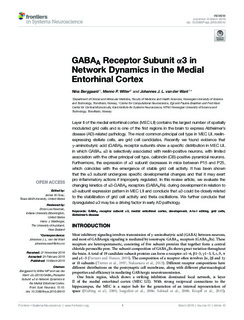| dc.contributor.author | Berggaard, Nina | |
| dc.contributor.author | Witter, Menno | |
| dc.contributor.author | van der Want, Johannes Jacobus Leendert | |
| dc.date.accessioned | 2019-09-25T15:42:47Z | |
| dc.date.available | 2019-09-25T15:42:47Z | |
| dc.date.created | 2019-03-21T14:32:55Z | |
| dc.date.issued | 2019 | |
| dc.identifier.citation | Frontiers in Systems Neuroscience. 2019, 13:10 1-8. | nb_NO |
| dc.identifier.issn | 1662-5137 | |
| dc.identifier.uri | http://hdl.handle.net/11250/2618822 | |
| dc.description.abstract | Layer II of the medial entorhinal cortex (MEC LII) contains the largest number of spatially modulated grid cells and is one of the first regions in the brain to express Alzheimer’s disease (AD)-related pathology. The most common principal cell type in MEC LII, reelin-expressing stellate cells, are grid cell candidates. Recently we found evidence that γ-aminobutyric acid (GABA)A receptor subunits show a specific distribution in MEC LII, in which GABAA α3 is selectively associated with reelin-positive neurons, with limited association with the other principal cell type, calbindin (CB)-positive pyramidal neurons. Furthermore, the expression of α3 subunit decreases in mice between P15 and P25, which coincides with the emergence of stable grid cell activity. It has been shown that the α3 subunit undergoes specific developmental changes and that it may exert pro-inflammatory actions if improperly regulated. In this review article, we evaluate the changing kinetics of α3-GABAA receptors (GABAARs). during development in relation to α3-subunit expression pattern in MEC LII and conclude that α3 could be closely related to the stabilization of grid cell activity and theta oscillations. We further conclude that dysregulated α3 may be a driving factor in early AD pathology. | nb_NO |
| dc.language.iso | eng | nb_NO |
| dc.publisher | Frontiers Media | nb_NO |
| dc.rights | Navngivelse 4.0 Internasjonal | * |
| dc.rights.uri | http://creativecommons.org/licenses/by/4.0/deed.no | * |
| dc.title | GABAA receptor subunit α3 in network dynamics in the medial entorhinal cortex | nb_NO |
| dc.type | Journal article | nb_NO |
| dc.type | Peer reviewed | nb_NO |
| dc.description.version | publishedVersion | nb_NO |
| dc.source.pagenumber | 1-8 | nb_NO |
| dc.source.volume | 13:10 | nb_NO |
| dc.source.journal | Frontiers in Systems Neuroscience | nb_NO |
| dc.identifier.doi | 10.3389/fnsys.2019.00010 | |
| dc.identifier.cristin | 1686747 | |
| dc.description.localcode | Copyright © 2019 Berggaard, Witter and van der Want. This is an open-access article distributed under the terms of the Creative Commons Attribution License (CC BY). The use, distribution or reproduction in other forums is permitted, provided the original author(s) and the copyright owner(s) are credited and that the original publication in this journal is cited, in accordance with accepted academic practice. No use, distribution or reproduction is permitted which does not comply with these terms . | nb_NO |
| cristin.unitcode | 194,65,15,0 | |
| cristin.unitcode | 194,65,60,0 | |
| cristin.unitname | Institutt for klinisk og molekylær medisin | |
| cristin.unitname | Kavliinstitutt for nevrovitenskap | |
| cristin.ispublished | true | |
| cristin.fulltext | original | |
| cristin.qualitycode | 1 | |

